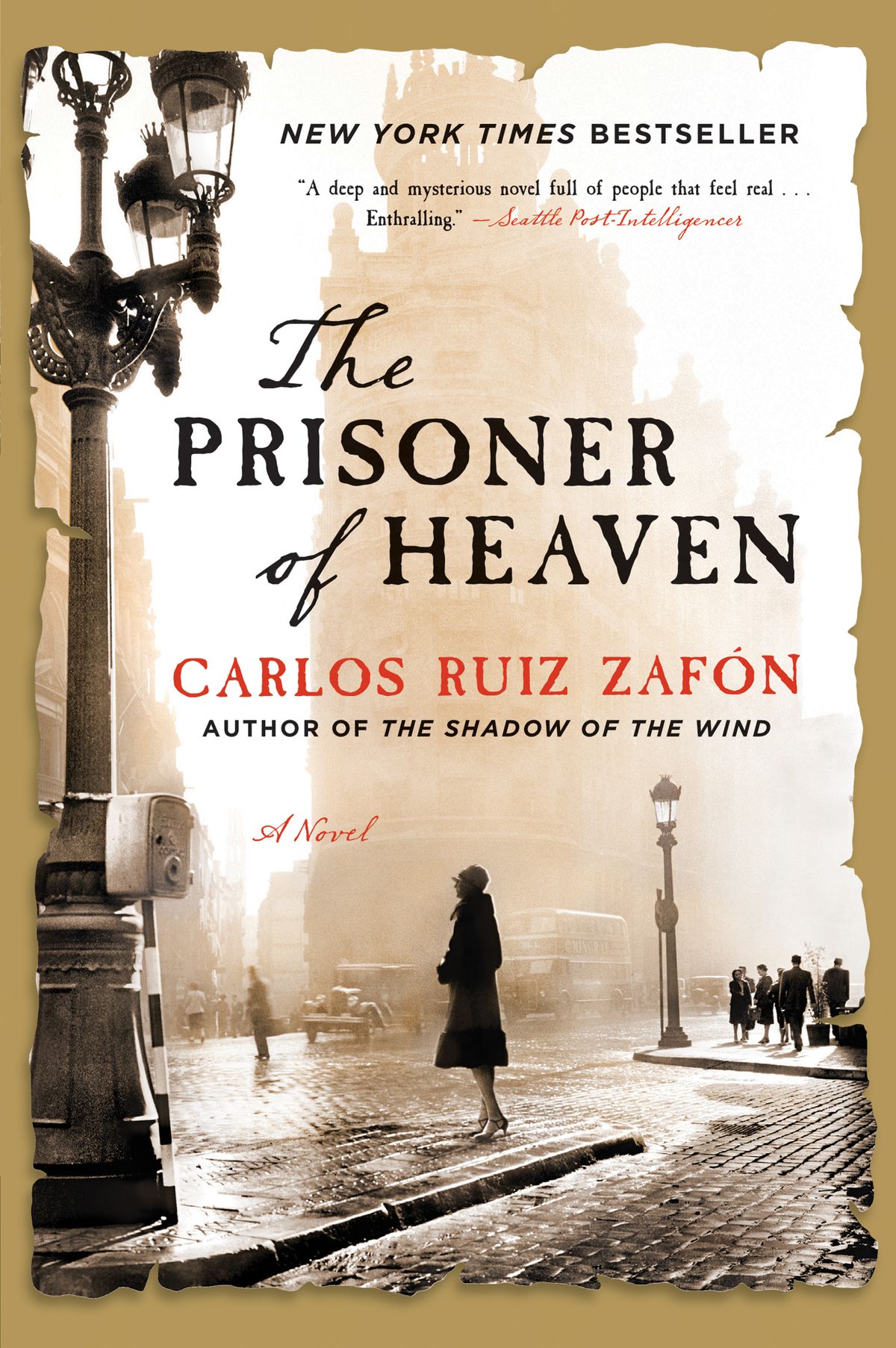It’s been nearly a month, but I’ve finally reached the end of Carlos Ruiz Zafón‘s Cemetery of Forgotten Books series! Following The Shadow of the Wind, The Angel’s Game, and The Prisoner of Heaven, the series closes with The Labyrinth of the Spirits. At over 800 pages, this is not only the longest book in the series – it’s the longest book I’ve ever read! And despite its daunting size, it actually may be my favorite book of the series.
Summary
True to its name, The Labyrinth of the Spirits is a complex, maze-like book. It pulls in characters from the previous three novels, but also introduces us to some important new ones, too. The Prisoner of Heaven, in particular, really did set us up for this monumental final book.
First the novel takes us back to 1938, when Fermín Romero de Torres returned to Barcelona – a city in which he was hunted by the sinister Javier Fumero – in order to deliver a letter. Instead of a simple delivery, though, he did all he could to save a little girl, Alicia Gris, who would be orphaned that night.
Fast forward to 1959, when another evil character we know – Mauricio Valls – lives in the lap of luxury, but also in fear for his life. After receiving some cryptic notes and escaping a murder attempt, Mauricio flees Madrid to save himself from his perceived danger.
This is where Alicia Gris – now grown up and working as a sort of detective – comes into the story. She and a police captain named Juan Manuel Vargas team up to find Valls, but as they move from Madrid to Barcelona, the threads of this web start to weave an ugly picture of corruption and murder. Their investigation intersects with the ordinary lives of the Sempere family and Fermín, but it’s a complicated journey in which no one is safe.
Review
If that summary is anything to go by, there is a LOT going on in The Labyrinth of the Spirits. Truth be told, that’s not event the half of it. Indeed, at over 800 pages, Carlos Ruiz Zafón has plenty of space to work with, and he makes the most of it.
In many ways, The Labyrinth of the Spirits is like a crime thriller. The author has always changed up the style from book to book, and this final installment is no different. Sure, it incorporates the literary mystery and gloomy vibes at the core of the series, but this time the story has more professional investigators and very real danger for all involved.
All of the important characters from the previous three books make a comeback here, in some way or another. Carlos Ruiz Zafón did an excellent job of connecting all the stories and weaving the disparate threads together. And even so, it feels like its own story, one that’s not dependent on the rest of the series, despite working so perfectly within it.
Daniel Sempere and Fermín Romero de Torres, of course, are prominent characters here. They aren’t just bookends to the story; they’re also important players within the main crime investigation portions, too. Daniel’s wife Beatriz also gets a larger role here, and finally, her character feels more fully developed. Their son Julián gets plenty of screen time (er, page time), and even his namesake Julián Carax makes an appearance near the end, truly bringing the series full circle.
The main character is Alicia Gris, a tough woman who’s fearless yet troubled. She suffers from a limp and constant pain from a childhood injury, and she’s definitely an alcoholic, but she’s also sharp, persistent, and brave. She’s a complicated woman, but a wonderful character. It’s also nice to have a woman be the protagonist here; it smooths out the issues of sexism that bothered me in The Shadow of the Wind. She still hears sexist comments from other male characters, but she quietly derides them or calls them out for it. She’s strong, and despite what the men in 1950s Spain may think, she can investigate better than they think, and she can totally save herself.
Carlos Ruiz Zafón has always written realistic characters, people who are imperfect and neither wholly good nor wholly evil. Well, some are totally evil, but there’s at least context for why they ended up that way. The same is true here. Mauricio Valls, for example, was the villain in The Prisoner of Heaven, and in many ways, he’s still a villain here. And yet he’s also a victim, and his suffering throughout the novel softened my view of him… perhaps undeservedly, considering the horrible things he’d done. But all of the characters here have their good and bad qualities, their good and bad actions. Some are duplicitous and good liars. The characterization is nuanced and thought-provoking, and even a bit surprising at times.
Throughout the series, we’ve seen characters die, sometimes causing us to cheer or sigh with relief, at others crushing us in misery. The Labyrinth of the Spirits offers its fair share of character deaths. About halfway through, one of my favorites gets murdered, which truly upset me. It was kind of heartbreaking. But instead of wallowing, the surviving characters sought revenge on all involved. Later, we learn about the death of one of my favorite characters from previous novels. Again, it was sad, if not fully shocking.
In classic Carlos Ruiz Zafón fashion, The Labyrinth of the Spirits gets a drawn-out ending, with extended epilogues that offer a glimpse into the rest of our characters’ lives.. until 1992, at least. We get to see Julián Sempere grow up, find career success, and start a family of his own. We see how Daniel and Beatriz and Fermín age, how Alicia finds her own path, how some people we thought were gone were actually still around all along.
It’s all satisfyingly tied up, assuaging any desire for more books. Indeed, The Labyrinth of the Spirits is the last book of the series, and the last novel Carlos Ruiz Zafón completed before his untimely death earlier this year.
Final Thoughts
I’ll admit, reading an 800-page novel was a bit daunting for me, but it was worth the time. The Labyrinth of the Spirits is a masterpiece, and probably my favorite of the Cemetery of Forgotten Books series. Although Carlos Ruiz Zafón always said readers can enter the series with any book – no need to read them in order – this one truly feels like a culmination of the previous three. It works as a standalone, but I expect it’s richer already knowing the characters and context.
This has been a wonderful series to read, and I’ll definitely go back and read some of Carlos Ruiz Zafón’s earlier books. I have my eyes on Marina and his new, posthumous short story collection, La Ciudad de Vapor, out later this month. Look out for reviews of those in the (hopefully near) future!
The Cemetery of Forgotten Books
The Shadow of the Wind
I first read Carlos Ruiz Zafón’s The Shadow of the Wind four years ago. At the time, it felt like one of the most magical, immersive stories I’d ever read. It wasn’t until a couple of years later that I found out it was the first in a series, and my mom was kind enough…
The Angel’s Game
I’m currently in the midst of reading Carlos Ruiz Zafón’s Cemetery of Forgotten Books series. Following my reread of his beloved The Shadow of the Wind, I’ve now just finished the second book in the series, The Angel’s Game. While it has much in common with the first book, The Angel’s Game is also wholly…
The Prisoner of Heaven
For the past few weeks I’ve been working my way through the Cemetery of Forgotten Books series by the late Carlos Ruiz Zafón. Following The Shadow of the Wind and The Angel’s Game, the third novel is The Prisoner of Heaven. In contrast to the other books in the series, this one is fairly short, at only 278…
Discover more from Amanda's Book Corner
Subscribe to get the latest posts to your email.





